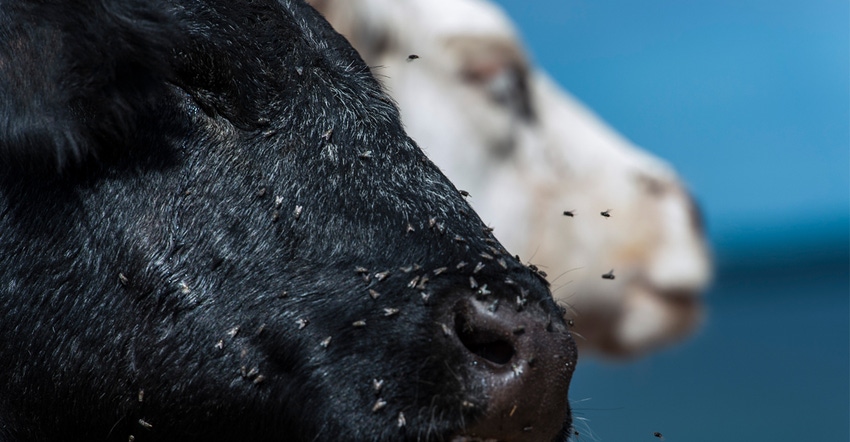Managing flies can save money and reduce cattle stress this season.

Flies can afflict cattle during warmer months. Various species can cause economic damage by decreasing milk production, impacting weaning rates and stressing cattle.
Finding the best control method for your herd requires some planning. Adele Harty, South Dakota State University Extension cow-calf field specialist, explains these four options:
1. Pour-on treatment. A pour-on treatment is applied by pouring the solution directly onto the animal. There are many options that exist, including those that resist horn flies. A top choice may be Boss pour-on, a 5% permethrin pour that has 87% to 100% efficacy against horn and face flies for up to four weeks. Saber is a lambda-cyhalothrin pour that has higher than 90% efficacy against horn flies for up to seven weeks. Both are produced by Merck Animal Health.
With any pour-on, proper dosing and usage will extend the efficacy against flies and other pests. The time of year may also play a role in which ingredient to select in your pour. For many producers, applying pour-on alone may be a time-consuming choice, especially during the grazing season.
Harty recommends using a pour-on in conjunction with another fly control method for the best results. “Effective control may require more than one method, including the use of insecticidal ear tags, dust bags and sprays,” she says.
2. Feed additives. Getting straight to the source, feed additives, like oral larvicides and insect growth inhibitors, work from the inside out for controlling flies. They work by passing through the cattle digestive system, effectively killing fly larvae from maturing in the manure.
Harty cautions that while these reduce the amount of larvae, this doesn’t necessarily correlate with a reduction in adults. “Flies may migrate to and from neighboring cow herds as well,” she says. A difficulty that may be encountered with feed additives is ensuring each animal consumes the appropriate dosage.
3. Fly tags. Insecticidal ear tags move the insecticide from the tag to the coat of the animal. “Tags are easy to apply and can be effective, but there is a history of horn fly resistance to the active ingredients used in some tags,” Harty says. General guidelines include:
tagging animals as late as possible to ensure maximum effectiveness when horn flies are present
only tagging mature cows and weaned calves
removing used tags at the end of the season
Harty also recommends to invest in high-quality tags, as lower-priced options may not be as effective. “We recommend to rotate tags with different active ingredients to impede resistance development,” she says. “Don’t apply insecticides from the same mode of action repeatedly, instead rotate between organophosphates, pyrethroids and pyrethrins, avermectins and milbemycins, juvenile hormone analogues, and benzoylurea chitin inhibitors.”
4. Dust bags and oilers. Dust bags and oilers can be a low-maintenance and effective form of pest control. These methods can either be utilized with a forced-use option or be free choice. “If these are not utilized as a forced-use option, expect 30% to 50% less control,” Harty says. “In a forced-use option, these offer good control, but require time checking and repairing bags.”
For dust bags, insecticidal dust covers the cattle as they walk underneath. Oilers work similarly, but with an oil-based insecticide. Hanging these bags low will ensure protection and coverage of the animal’s face as they walk underneath.
No matter the operation, using multiple modes of action and methods of protection may offer more effective fly protection, and protect against creating pesticide resistance. For more information regarding fly management and control, check out Fly Control Considerations for Cattle on Pasture.
About the Author(s)
You May Also Like





